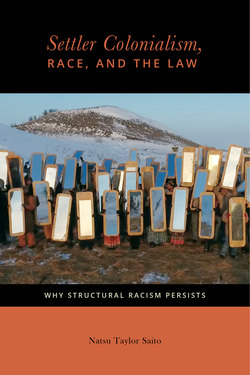Settler Colonialism, Race, and the Law

Реклама. ООО «ЛитРес», ИНН: 7719571260.
Оглавление
Natsu Taylor Saito. Settler Colonialism, Race, and the Law
Settler Colonialism, Race, and the Law. Why Structural Racism Persists
Contents
Introduction
1. Racial Realities
Persistent Disparities
Activism Rekindled
Liberatory Visions
Retrenchment and Repression
Moving Forward
2. Unsettling Narratives
The Master(’s) Narrative
A Story of Progress
A Story of Race and Gender
A Story of Property
Silent Spaces
The Violence of Colonization
Indigenous Worlds
Many Worldviews
3. Settler Colonialism
Colonialism: An Overview
External Colonialism
Internal Colonialism
Settler Colonialism
Colonialism and Genocide
First Principles
4. Land and Indigenous Peoples
Racialization
Strategies of Elimination
Direct Killing, or Officially Sanctioned Massacres
Privatized Violence
Indirect Killing, or Disease
Sterilization
Contemporary Violence
Strategies of Displacement and Containment
Forced Removals
Internments
Strategies of Conceptual Disappearance
“Recognition”
Assimilation
Indians as Anachronism
Looking Ahead
5. Enslaved Labor and Strategies of Subjugation
Slavery
Contested Identities
Racialization
Strategies of Subjugation. Population Control
Forced Reproduction
The “One Drop” Rule
Spatial Containment
Violence and Terror
6 “Emancipated” African Americans. Rights and Redundancy
Reconstruction and Retrenchment
Landownership
Geographic Containment
Economic and Social Exclusion
Criminalization and Convict Labor
Violence and Terror
American Apartheid
Separate and Unequal
The Civil Rights Era
Ongoing Strategies of Subjugation
Racialization
Property Ownership
Spatial Containment and Social Control
Population Reduction
Mass Incarceration
Officially Sanctioned Violence and Terror
7. Others of Color. Inclusions and Exclusions
Framing the Inquiry
Theorizing “Others”
Colonial Functions and Strategies
Citizenship
Territorial Expansion
Labor
Chinese Labor
Mexican Labor
Filipina/o Labor
Immigration Restrictions
Chinese Exclusion
National Origin Quotas
Permanent Residents and the 1965 Reforms
Temporary Workers
Unauthorized Workers
Refugees
Refugee and Asylum Policies
War Refugees
Unwanted Peoples
8. Others of Color. Subordination and Manipulation
Racialization
Racial Caricatures
Perpetual Foreignness
Racial Conflation
Racial Manipulation
Assimilationism
Assimilation as Conceptual Disappearance
Assimilation as Illusion
Strategies of Subordination
Property Ownership. Mexican Land Grants
Alien Land Laws
Spatial Containment
Population Control
Criminalization
Presumptions of Criminality
Threats to National Security
Violence and Intimidation
9. Constitutional Protection and the Dynamic of Difference
Plenary Power
Constitutional Equal Protection
Assimilationism
10. International Law and Human Rights
States in International Law
Fundamental Human Rights
Human Dignity
Racial Discrimination and Xenophobia
Rights of Indigenous Peoples
Genocide
Legal Redress
Basic Principles
Two Case Studies
Western Shoshone Land Claims
Border Killings
International Law in US Courts
Calls for Enforcement
Attempts at Containment
11. Decolonization and Self-Determination
The “Decolonization Era”
The Right to Self-Determination
Territorial Integrity
Defining Peoples
Moving beyond “Universality”
Thinking beyond States
Self-Determination as a Continuing Process
Nations Within
Native Nations
“Nations Becoming”
12. Mapping New Worlds
Identities
Reclaiming Histories
Reconstructing Identities
Strategies
Actions
Conclusion. We Won When We Started
Acknowledgments
Notes. Introduction
Chapter 1. Racial Realities
Chapter 2. Unsettling Narratives
Chapter 3. Settler Colonialism
Chapter 4. Land and Indigenous Peoples
Chapter 5. Enslaved Labor and Strategies of Subjugation
Chapter 6. “Emancipated” African Americans
Chapter 7. Others of Color: Inclusions and Exclusions
Chapter 8. Others of Color: Subordination and Manipulation
Chapter 9. Constitutional Protection and the Dynamic of Difference
Chapter 10. International Law and Human Rights
Chapter 11. Decolonization and Self-Determination
Chapter 12. Mapping New Worlds
Conclusion
Works Cited. Articles, Chapters, and Online Documents
Books
Official Documents
List of Cases
Index
About the Author
Отрывок из книги
CITIZENSHIP AND MIGRATION IN THE AMERICAS
General Editor: Ediberto Roman
.....
Direct governmental repression is, no doubt, part of how we came to this place, a phenomenon that has not abated over the past several decades, regardless of who is president or which political party controls Congress.98 All of the movements of the 1960s were subjected to intensive surveillance, infiltration, and the use of disinformation to create splits within organizations and to discredit them in the public eye, most famously through the COINTELPRO (counterintelligence program) operations of the FBI.99 Organizations perceived as the most “radical” faced barrages of criminal prosecutions that relied on false testimony and fabricated evidence to incarcerate their leadership and to divert their resources into protracted legal defense efforts.100 When these tactics failed to meet their stated goal of “neutralizing” threats to the status quo, leaders such as Fred Hampton and Mark Clark of the Illinois Black Panthers were simply assassinated.101 In other cases, as in the 1973 siege of American Indian Movement activists and supporters at Wounded Knee, armed force was intensively deployed and military counterinsurgency methods subsequently used to undermine support for AIM on the Pine Ridge Reservation.102
Under these conditions it is not surprising that many of those who once identified as “warriors” would come to consider defending their communities and creating alternative institutions to be, at best, an exercise in futility. No one was held responsible for the violations of constitutional rights attending COINTELPRO or similar governmental operations, despite their being condemned as illegal and unconstitutional by a Senate oversight committee. Instead, many victims of these operations remain incarcerated today.103 For the most part, organizations that advocated self-determination for people of color under US jurisdiction have been erased from mainstream history or are portrayed as “gangs” of criminals and thugs.104 Numerous COINTELPRO tactics have since been legalized in the “war on terror”105 and advocates of “separatism” are now classified as extremists and potential terrorists not only by the FBI but also by liberal organizations such as the Southern Poverty Law Center.106
.....